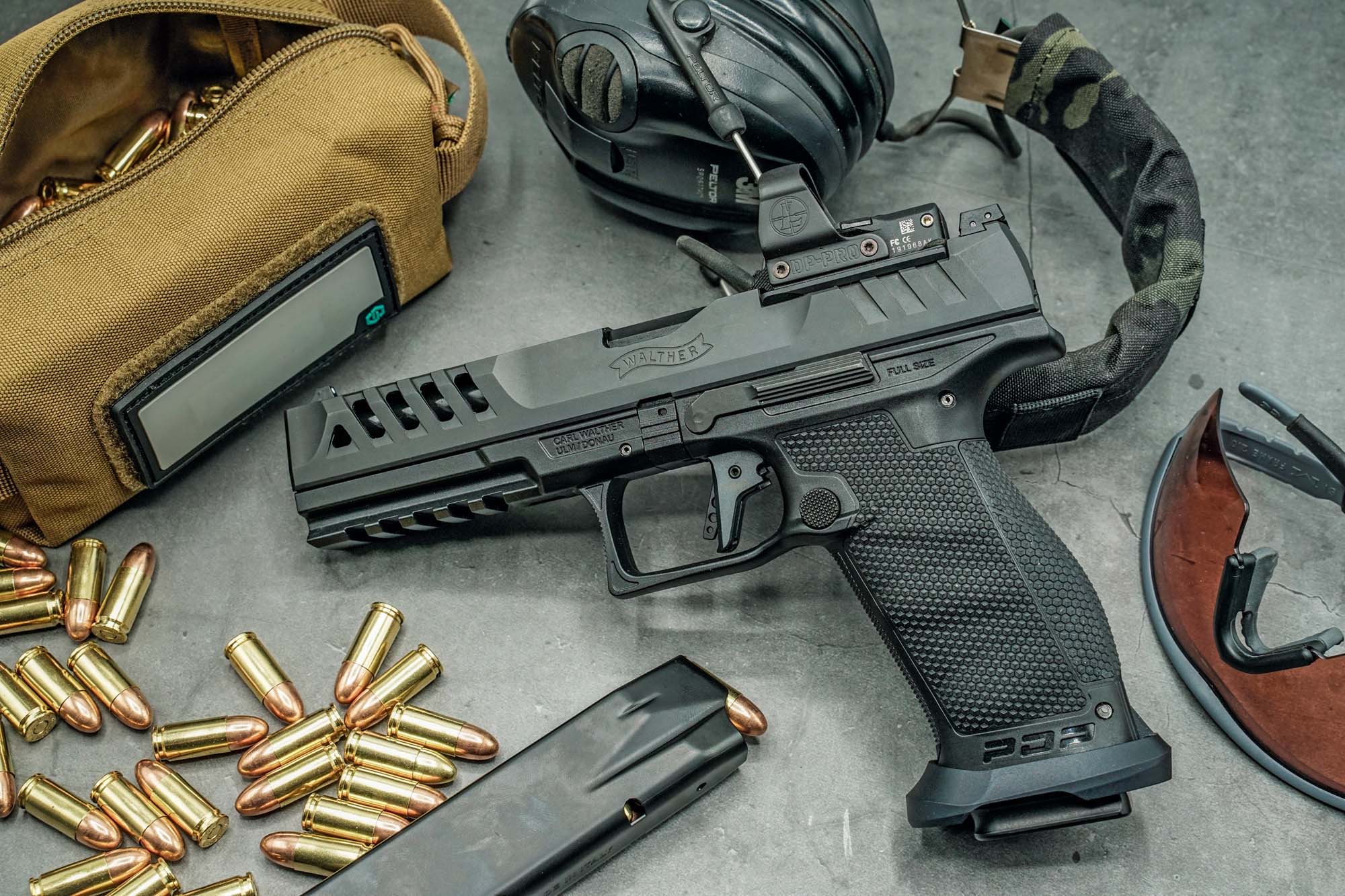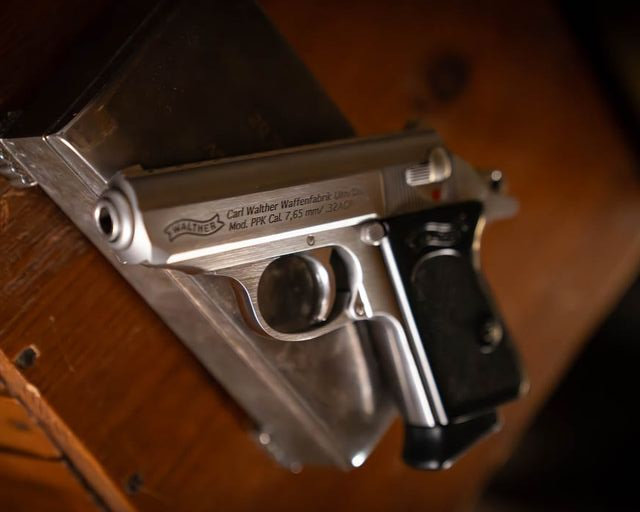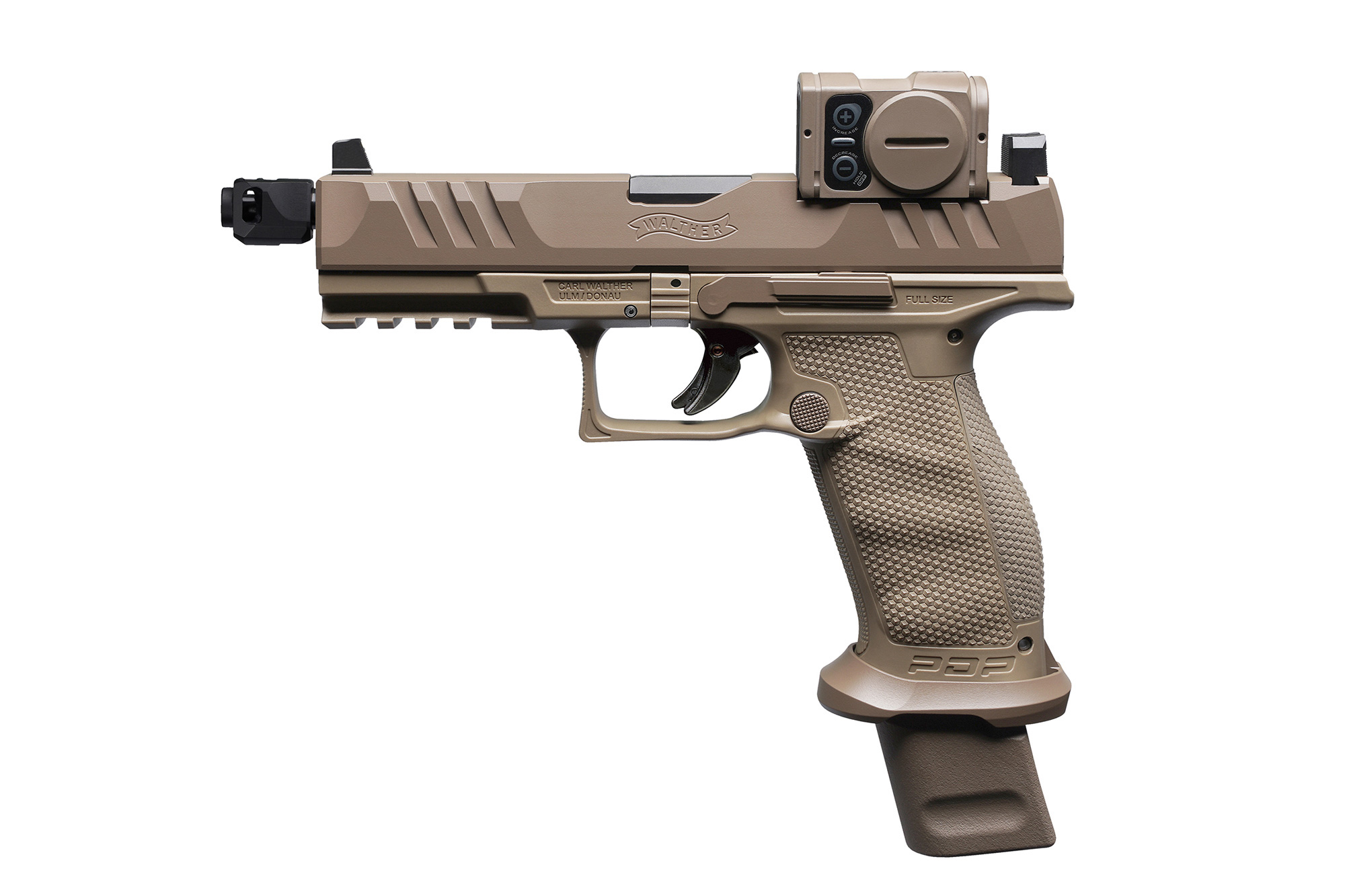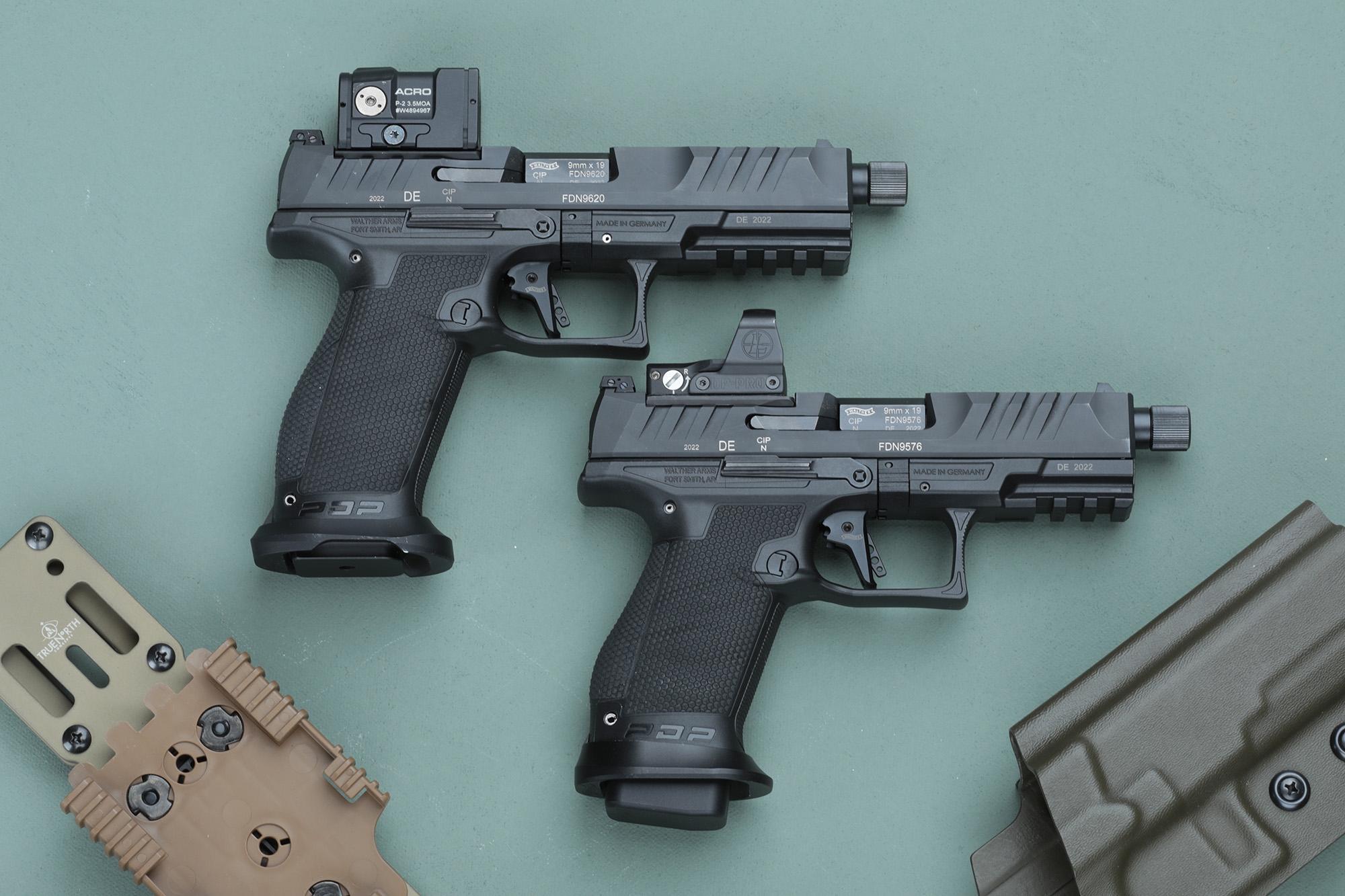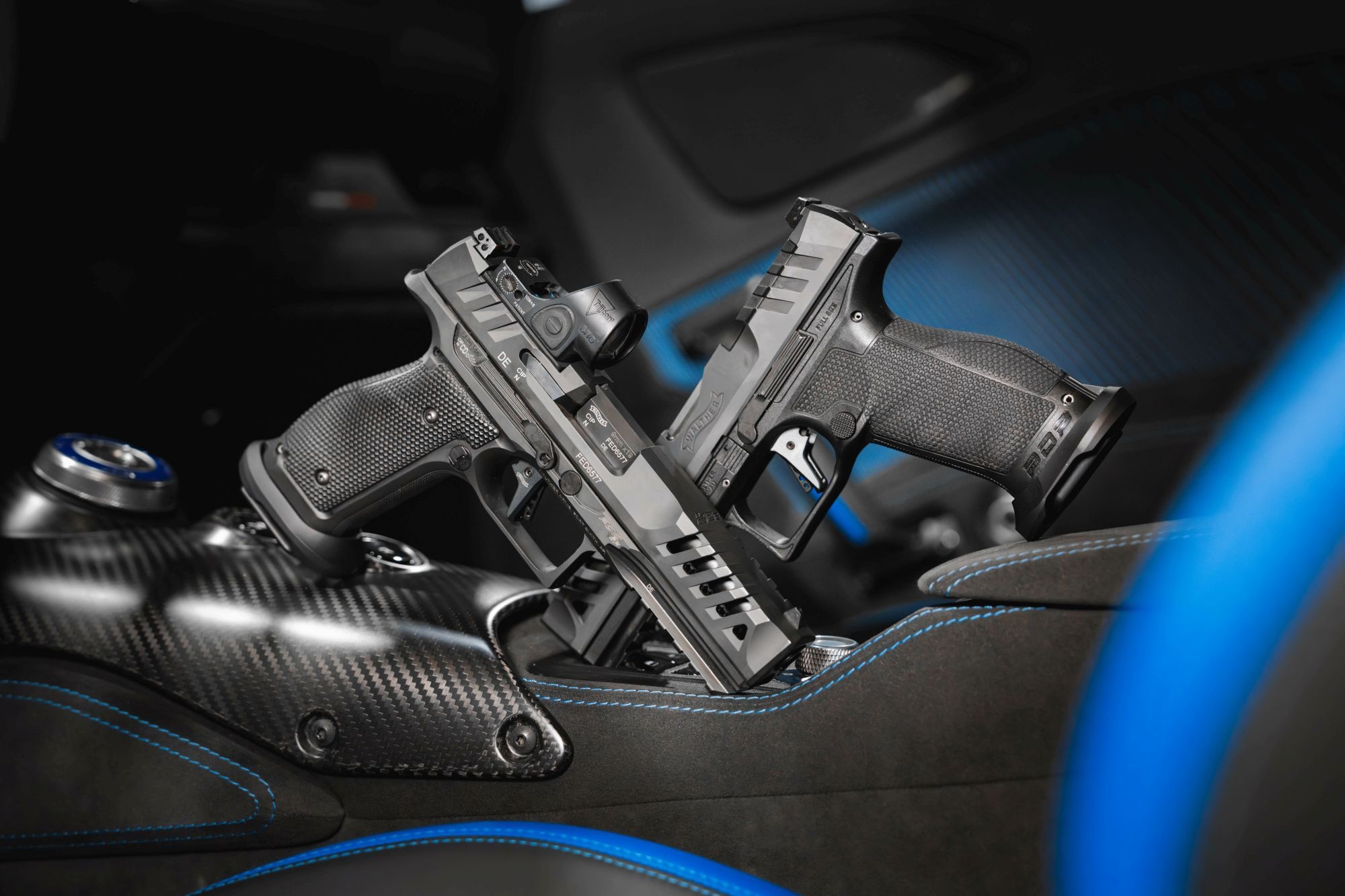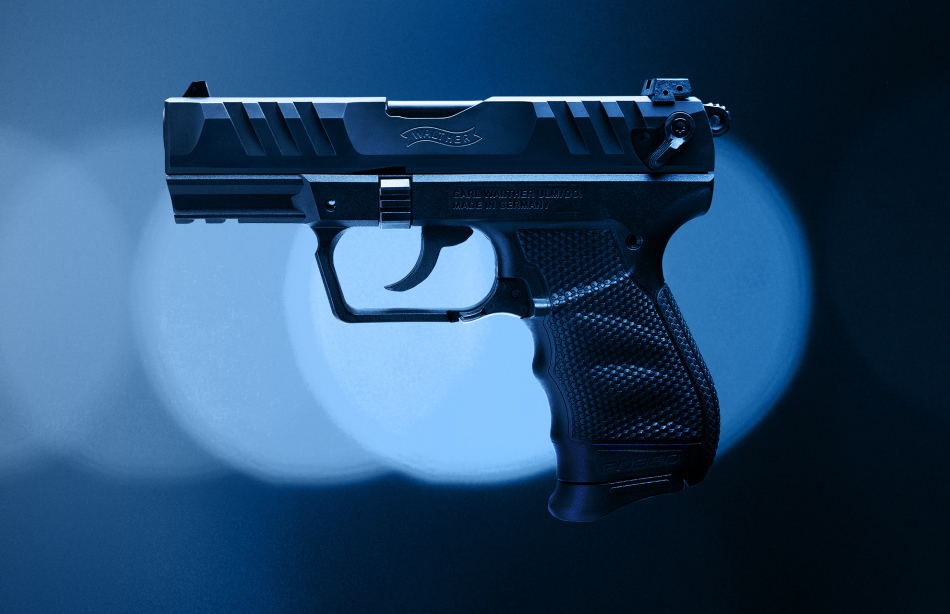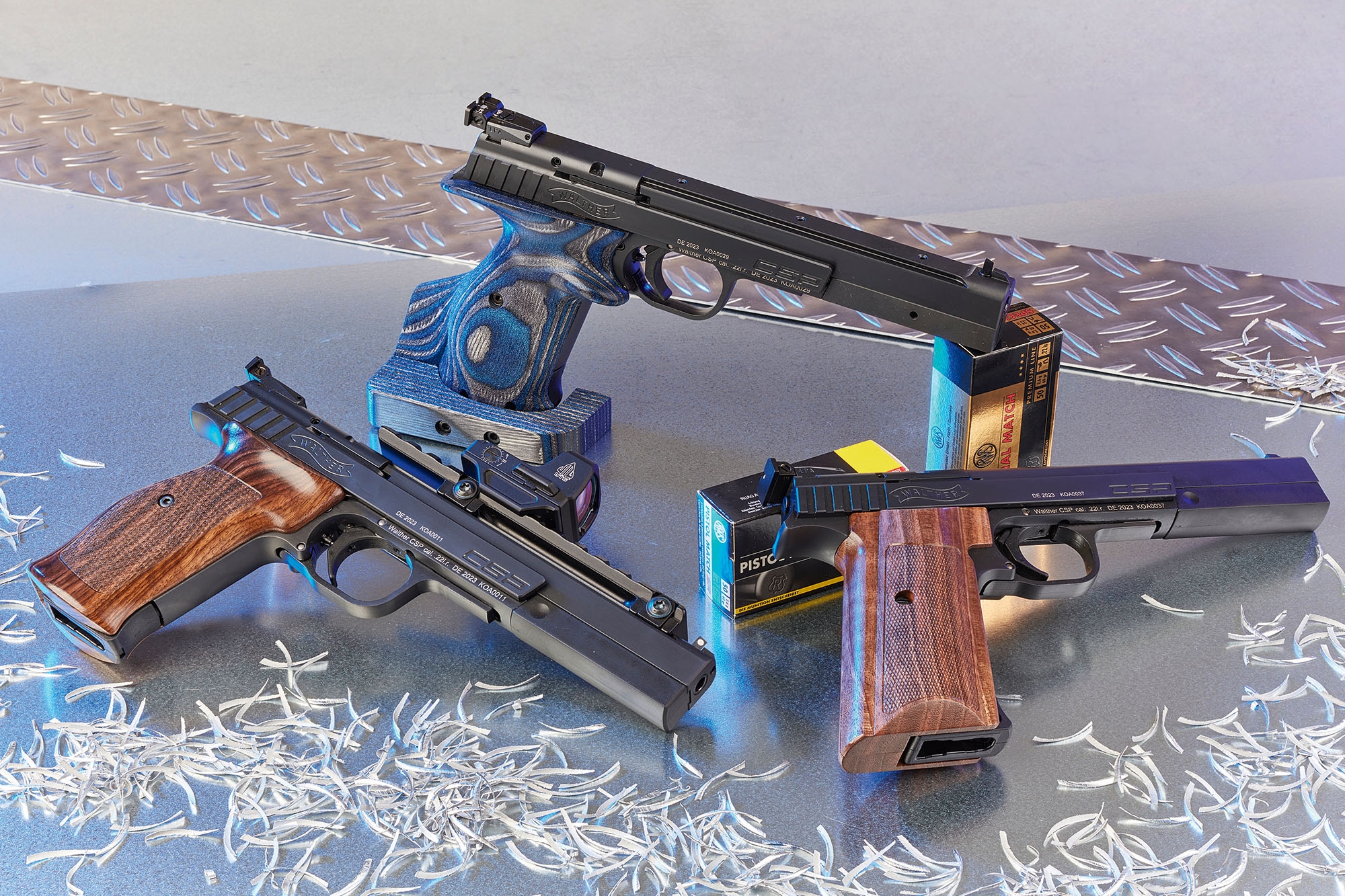It's amazing how heavy all-steel pistols feel when only polymers have been available for a long time. And this from the same manufacturer and under the same product designation. Even the short Walther PDP Steel Frame Compact felt heavy as lead. A PDP Compact with a polymer frame weighs around 700 grams, the all-steel Compact, with the abbreviation SF for Steel Frame, almost 1,100 grams. The exact figure was 691 to 1,095 grams. The difference of around 400 grams rang a bell with the editors. This is because the difference in weight between the steel frame version of the Walther Q5 Match presented a good five years ago and the version with a polymer grip frame was also around 400 grams. Walther is practically a repeat offender with the configuration of polymer to steel grips within its pistol series. And that's a good thing, because a polymer frame can't simply be converted to steel. It starts with the wall thicknesses. Simply transferring the polymer dimensions into steel would sooner or later result in cracks in the steel grip. This is because the fiber-reinforced plastic of a polymer frame absorbs the forces of the slide hitting the end of its rearward travel much better than metals. This fact extends to all relevant parts of the frame, including the slide guides. The guide widths of the polymer and steel slide are different. This explains why it is not possible to switch from polymer to steel (SF) grips.

The Walther PDP SF Compact OR in detail
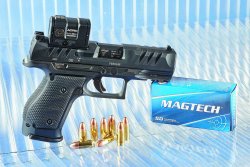
Visually, it looks confusingly similar to the polymer version of the same size. The subtle differences only become apparent on closer inspection. Instead of the takedown catch on the frame of the polymer-version PDP, the SF version has a slightly protruding takedown lever on the left side. The contours of the chamber and its locking pieces also differ, and thus inevitably also the barrels. If only the different backstraps are replaced on the polymer-framed PDP to optimise the hand position, on the SF Compact the grip scales must be replaced. Two T-shaped profiled polymer strips are concealed underneath each side (the Q5 Match also had them). The strips not only allow the magazines to slide almost like velvet paws in the PDP SF magazine well, they also guide the magazines of its polymer sister. This makes it possible to replace this very important assembly. Otherwise, the identical components are more likely to be found in the small parts segment, such as the magazine release or the sights. And despite all the similarities, not even the holster for the polymer PDP fits its steel siblling. That's how different the guns really are. However, when asked about holsters, Walther gave two positive answers: a suitable holster for the PDP-SF is in development and is also designed for red dot sights.
The Walther PDP SF Full Size OR in detail
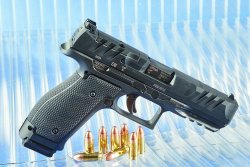
Around 1,160 grams, that is also a word – namely: mass! The extra 60 grams of weight of the PDP Full Size (FS) version compared to the Compact are distributed between the slightly longer frame and the half-inch, approximately 12 mm, longer slide. The latter has an inevitably longer barrel and, unlike the Compact, the grip now holds 18-round magazines instead of 15 cartridges. Otherwise, the differences to the Compact are marginal. The finger grooves on the grip scales are less prominent on the Full Size model. The slightly thicker magazine base plate of the FS is shorter because, unlike the magazines for the Compact, it lacks the pronounced finger extention pointing towards the muzzle. The flat but well-contrasting open sights are common to all variants, and the rear sight can be adjusted in windage and elevation. The very tactile magazine release can be repositioned. This also turns the "steel ones" into a fully left-handed pistol, as the slide stop is on both sides. Reflex sights can also be fitted to all variants. At present, these are models from Trijicon, Leupold, Noblex/Docter, Aimpoint (Acro) and Holosun (509T). All testers found the mounting very convenient: the mounting screws for the cover plate, as well as for mounting the red dots, are M3 type and have a size 10 Torx drive profile, so there is sufficient stability for many mounting cycles on models used for sporting purposes to swap the red dot sight for an open sight. However, not all manufacturers of reflex sight-ready pistols have recognised the value of large, high-quality and, above all, tamper-proof screws.
The Walther PDP SF Match OR in detail
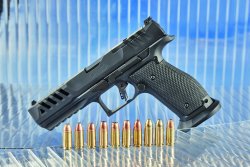
A little longer, another half an inch – that could be the short version of the main difference. Then there are the cut-outs in the slide, which only cause the scales to show an increase in weight of around 50 grams, to 1,210 grams. A generously dimensioned magwell eliminates possible insertion fiddling with this SF variant, which is primarily configured for sporting purposes. Since only a hollow dowel pin needs to be driven out, the magwell can also be fitted to other SF variants. Apart from the longer sight radius, which is conducive to sporting use, the Match rightly deserves its name, especially because of the very defined trigger release. No jerking, no "round" feeling at the wall, no creep – simply great. But beware! The "normal" triggers of the two pistols described above featuring a curved instead of a straight blade, and also those of the polymer-frame PDPs, are already well above many competitors thanks to their clean characteristics.
Test: on the shooting range with the three Steel Frame pistols from Walther
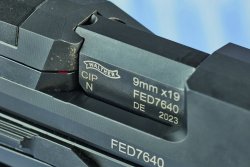
First came the PDP SF Compact. An Aimpoint Acro C-2 was fitted. 15 metres is a practical distance, which is already a long range for self-defense, so it was important to use suitable ammunition. Once again, the groupings show that red dot aid can achieve incredibly good results even with compact pistols. Just a few years ago, it would have been almost impossible to achieve these groupings with open sights. Since a Walther PDP Compact with a polymer frame, also with an Aimpoint Acro C-2, was available for comparison, some conclusions can be drawn: untimed, calmly aimed single shots can be fired equally accurately with both frame versions. However, if pressure is built up over time, more hits per unit of time can be achieved with the "shooting iron" than with the polymer-framed gun. The compact class grip still offers sufficient surface for medium-sized hands, beyond that it becomes tight for the little finger. Since an ergonomically optimised grip that also offers support for all fingers is essential for fast strings or follow-up shots, the larger grip is more suitable in case of doubt. This is where the shooting of the PDP Full Size begins. For the manual dynamic part of the three pistols, the 123-gr Fiocchi load with lead round nose and gas check had to be used. Despite its "soft" bullet construction, this 9mm cartridge is very powerfully loaded, reaching up to 380 metres per second at the muzzle and delivering 580 joules, depending on the gun. The ideal tool for testing the shooting behaviour of tough loads from polymer to steel, but also between the differently configured steel grips. And after just a few magazines, it was clear that only very well-trained and strong handgun shooters would be able to achieve similarly fast and precise shooting from the polymer PDP variant compared to the all-steel models. This speaks in favour of the all-steel models.
The match machine: the Walther PDP SF Match in action. In contrast to the compact version, the PDP SF Match was clamped in the shooting rest. Apart from the fact that the majority of groupings at 25 meters are safely within the ISSF ten of 50 mm in diameter, the only striking feature is the great homogeneity of the groups. Thanks to the excellent trigger characteristics and red dot aid, many shots into the ten could also be achieved manually with the "long" model. However, for the match variant, the focus is less on static and more on dynamic shooting. In addition to IPSC, the PDP SF Match should also score points in multi-range disciplines. There were no malfunctions or other anomalies with any of the test guns. However, with a manufacturer that has well over 100 years of experience in making semi-auto pistols, this is hardly surprising. And at this point I would also like to praise the (Italian) magazines. Some force is required to top off the last cartridges, but overall the magazines are very smooth to load.
Walther PDP Steel Frame Compact, Full Size, Match: specs and price at a glance
| Manufacturer: | Carl Walther (Ulm) | Carl Walther (Ulm) | Carl Walther (Ulm) |
| Model: | PDP Compact Steel Frame OR | PDP Full Size Steel Frame OR | PDP Match Steel Frame OR |
| Price: | 1,899 euro | 1,899 euro | 2,199 euro |
| Caliber: | 9mm Luger | 9mm Luger | 9mm Luger |
| Capacity: | 15+1 rounds | 18+1 rounds | 18+1 rounds |
| Dimensions (Lx WxH): | 188x36x137 mm | 201x35x145 mm | 213x40x150 mm |
| Barrel Length: | 102 mm | 114 mm | 127 mm |
| Twist Length: | 250 mm, 6 grooves, polygonal | 250 mm, 6 grooves, polygonal | 250 mm, 6 grooves, polygonal |
| Trigger Pull Weight: | 2,500 g | 2,500 g approx. | 2,500 g approx. |
| Weight: | 1,100 g | 1,145 g | 1,210 g |
| Right/Left version: | Ambidextrous (after repositioning the magazine release). | Ambidextrous (after repositioning the magazine release). | Ambidextrous (after repositioning the magazine release). |
| Features: | All-metal pistol, polygonal rifling, elevation- and windage-adjustable rear sight, sights with white lacquer dots, two spare magazines with loading tool, plastic case. | All-metal pistol, polygonal rifling, elevation-adjustable rear sight, sights with white lacquer dots, two spare magazines with loading tool, magwell, plastic case. | All-metal pistol, polygonal rifling, elevation-adjustable rear sight, sights with white lacquer dots, two spare magazines with loading aid, magwell, plastic case. |
Test result: what the three Walther PDP SF variants Compact, Full Size and Match can offer
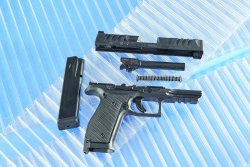
It is a well-known fact that mass is still the best recoil brake. And a loaded Walther PDP SF full-size with mounted red dot, for example, has enough mass. Around three pounds. Unfortunately, it is rare to be able to compare products from the same manufacturer with different weights but almost identical ergonomics and feel. Taking advantage of this opportunity, the testers also shot several hundred cartridges freehand at round targets. Therefore, there is a clear conclusion:
if you want to carry less weight on your belt and prefer polymer guns, you should be wiry, muscular and well trained when it comes to fast and accurate shots. Less trained or physically weaker shooters, for whom quick and accurate shots are also important for occasional use, should forego some carrying comfort and make use of the additional weight of the steel frames as a compensator.
Further information on the steel versions of the PDP and other Carl Walther firearms can be found on the company's website.



